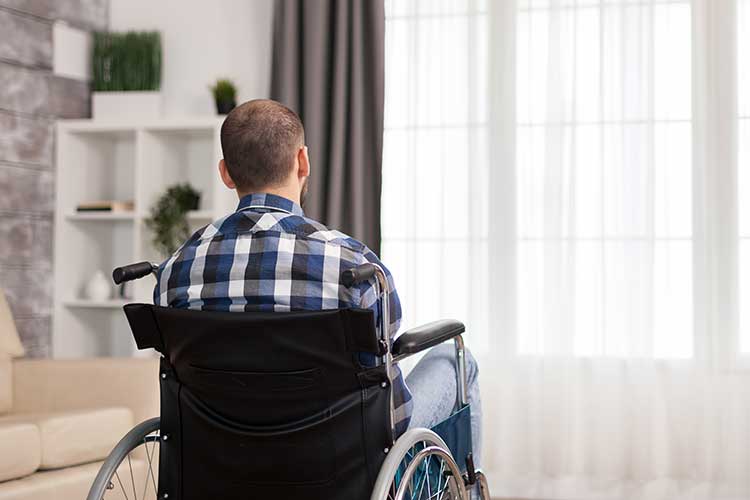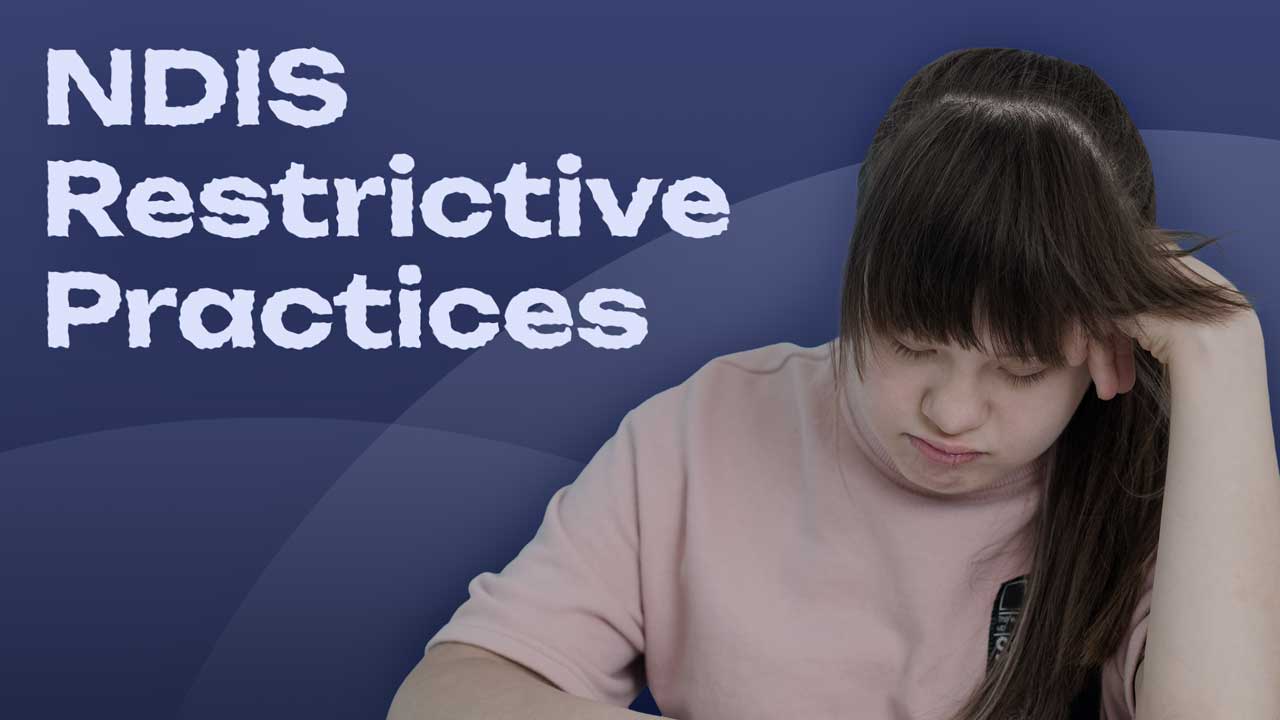Content warning: Please be aware that this Article contains discussions related to abuse, which some people may find distressing.
‘They were just managing her. And they actually said that – “we don’t have a program for [daughter]. We are just managing her. We are maintaining her, containing her and restraining her. That’s all we do here.”’
‘They want us to have a normal home but they lock the doors. That’s not normal when you live at home.’
‘… There would be fifteen people standing around [her] taking it in turn to hold her down. And they would be doing it for up to an hour.’
(DHHS 2009)
The above quotes, which were included in the 2009 research report Experiences of Restrictive Practices: A View From People With Disabilities and Family Carers, detail real experiences faced by people with disability, as told by care recipients and their families.
These are just a few of the many stories illustrating the potential harms of restrictive practices.
What are Restrictive Practices?
As part of their Zero Tolerance initiative, the NDS has released a series of seven films on restrictive practices. View them here.
Under the National Disability Insurance Scheme Act 2013, a restrictive practice is defined as ‘any practice or intervention that has the effect of restricting the rights or freedom of movement of a person with disability’.
Escalating situations might require the use of regulated restrictive practices. The goal of restrictive practices is to prevent an emergency or protect the participant, as well as those around them, from severe behaviours that are potentially harmful (NDIS 2020a).
Severe behaviours that are potentially harmful are known as behaviours of concern. Examples include:
- Breaking an object
- Hitting or harming another person
- Hitting or harming themselves
- Yelling at another person
- Attempting to flee.
(NDIS 2021; Disability Support Guide 2023)
Restrictive practices are recognised as potentially harmful breaches of human rights. For this reason, they must only be used if there are no other suitable options remaining, and for the shortest amount of time possible (NDIS 2020a).
A behaviour support plan that has been developed by an NDIS behaviour support practitioner and based on a behaviour support assessment may include regulated restrictive practices if required (NDIS 2024a).
A behaviour support plan that contains a restrictive practice should be reviewed at least every 12 months (NDIS 2024b).
The requirements surrounding restrictive practices are outlined in two modules of the NDIS Practice Standards: Practice Standard Module 2: Specialist Behaviour Support and Practice Standard Module 2A: Implementing Behaviour Support Plans.
Types of Restrictive Practices
The National Disability Insurance Scheme (Restrictive Practices and Behaviour Support) Rules 2018 identifies five restrictive practices requiring regulation and oversight by the NDIS Commission. These are:
1. Seclusion
Confining a person in a room or physical space by themselves (at any hour of the day or night) and preventing them from leaving voluntarily, or implying that they cannot leave voluntarily.
2. Chemical restraint
Using medications or chemical substances to influence a person’s behaviour. This does not include medications that a medical practitioner has prescribed to treat a mental or physical condition.
3. Mechanical restraint
Using devices such as gloves, helmets, straps and restrictive clothing to restrict a person’s movement with the purpose of influencing their behaviour. This does not include devices used for therapeutic or non-behavioural purposes, e.g. a wheelchair.
4. Physical restraint
Using physical force to prevent, restrict or subdue the movement of a person’s body with the purpose of influencing their behaviour.
5. Environmental restraint
Restricting a person’s free access to environments, items or activities.
(Adapted from NDIS 2020a)

Prohibited Restrictive Practices
The following types of restrictive practices are prohibited:
- Certain types of physical restraint associated with a high risk of injury and death, including:
- Prone restraint (forcing a participant face-down)
- Supine restraint (forcing a participant face-up)
- Pinning a participant down
- Basket holding (wrapping arms around a participant’s upper and/or lower body)
- Takedown techniques (forcing a participant to fall to the floor)
- Physically restraining a participant in a way that impairs respiratory or digestive functioning
- Pushing a participant’s head forward onto their chest
- Inflicting pain, hyperextending joints or putting pressure on the chest or joints
- Using restrictive practices as punishment
- Taking away basic needs or supports.
(NDIS 2020a; NDIS 2021)
When are Restrictive Practices Permitted?
Note: The NDIS Commission does not authorise restrictive practices; instead, providers must follow authorisation processes in accordance with their relevant state or territory’s legislation (NDIS 2020b).
There are strict conditions under which restrictive practices are permitted. All of the following requirements must be met for a restrictive practice to be used:
- The restrictive practice is clearly identified in the participant’s behaviour support plan
- The restrictive practice is authorised in accordance with processes set out in the relevant state or territory legislation
- The restrictive practice is being used as a last resort to protect the participant or others from harm, and the provider has already considered and applied evidence-based, person-centred and proactive strategies
- The restrictive practice being used is the least restrictive option possible, considering the circumstances
- The restrictive practice is being used to decrease the risk of harm to the participant or others
- The restrictive practice is proportionate to the potential negative consequences or harm
- The restrictive practice is used for the shortest length of time possible.
(NDIS 2020a)
Issues Relating to Restrictive Practices
Restrictive practices can have severe consequences on the health and wellbeing of people living with disability (NDS 2021). They may:
- Fail to properly address underlying behavioural factors
- Cause new behaviours of concern to arise
- Trigger those who have a history of trauma or abuse
- Cause trauma or psychological distress
- Result in loss of dignity for the person being restrained
- Limit a person’s personal freedom and ability to engage in daily activities
- Decrease meaningful interactions with carers and support workers
- Lead to an over-reliance on restrictive practices, causing the person to seek restraint or feel anxious without restraint
(NDIS 2020a)

Misuse of Restrictive Practices
Restrictive practices should never be used:
- Without proper authorisation
- Without the knowledge that what is being performed is restrictive
- For a prolonged period of time
- Without regular reviews
- For any reason other than keeping people safe
- To control a person or make them act in a specific way
- To abuse or neglect someone
- To compensate for a lack of training or knowledge
- Without considering less restrictive options.
(NDS 2021)
Unauthorised Restrictive Practices
Read: Incident Management: NDIS Provider Governance and Management
The unauthorised use of a restrictive practice is a reportable incident under the NDIS, meaning that the NDIS Commission must be notified if the unauthorised use of a restrictive practice occurs (NDIS 2019).
A restrictive practice is unauthorised if at least one of the following is true:
- The restrictive practice has not been authorised by the relevant state or territory legislation
- The restrictive practice is used within a state or territory that does not have an authorisation process for that particular practice, and it is not being used in accordance with a behaviour support plan
- The participant does not have a behaviour support plan or interim behaviour support plan
- The restrictive practice is not included in the participant’s behaviour support plan or interim behaviour support plan
- The restrictive practice is being used in a way that is inconsistent with the requirements or directions set out in the participant’s behaviour support plan.
(NDIS 2019)
Any restrictive practice that results in serious injury to the participant is also a reportable incident that the NDIS Commission must be notified of (NDIS 2019).
Reporting Requirements for Restrictive Practices
The implementing provider of a restrictive practice is required to make monthly reports to the NDIS Commission. This can be done through the NDIS Commission Portal (NDIS 2020b).
Test Your Knowledge
Question 1 of 3
Which one of the following is an example of restraint?
Topics
Further your knowledge
References
- Department of Health and Human Services 2009, Experiences of Restrictive Practices: A View From People With Disabilities and Family Carers: A Final Research Report to the Office of the Senior Practitioner, Victoria State Government, viewed 9 September 2024, https://www.dffh.vic.gov.au/sites/default/files/documents/202110/Experiences%20of%20restrictive%20practices%20report.pdf
- Disability Support Guide 2023, Restrictive Practice and the NDIS, Disability Support Guide, viewed 9 September 2024, https://www.disabilitysupportguide.com.au/information/article/restrictive-practice-and-the-ndis
- National Disability Services 2021, Recognising Restrictive Practices: Guide, NDS, viewed 9 September 2024, https://nds.org.au/images/zt/Recognising_Restrictive_Practices_Guide.pdf
- NDIS Quality and Safeguards Commission 2020b, Behaviour Support and Restrictive Practices, Australian Government, viewed 9 September 2024, https://www.ndiscommission.gov.au/sites/default/files/2022-02/fact-sheet-behaviour-support-under-ndis-commission-july-2020-final.pdf
- NDIS Quality and Safeguards Commission 2021, Regulated Restrictive Practices: Easy Read Guide, Australian Government, viewed 9 September 2024, https://www.ndiscommission.gov.au/sites/default/files/2022-07/regulated-restrictive-practices-guide-easy-read.pdf
- NDIS Quality and Safeguards Commission 2020a, Regulated Restrictive Practices Guide, Australian Government, viewed 9 September 2024, https://www.ndiscommission.gov.au/sites/default/files/2022-02/regulated-restrictive-practice-guide-rrp-20200_0.pdf
- NDIS Quality and Safeguards Commission 2019, Reportable Incidents: Detailed Guidance for Registered NDIS Providers, Australian Government, viewed 9 September 2024, https://www.ndiscommission.gov.au/sites/default/files/2022-02/detailed-guidance-reportable-incidents-detailed-guidance-registered_0.pdf
- NDIS Quality and Safeguards Commission 2024b, Understanding Behaviour Support and Restrictive Practices - for Participants, Australian Government, viewed 9 September 2024, https://www.ndiscommission.gov.au/participants/incidents-and-behaviour-support/understanding-behaviour-support-and-restrictive-0
- NDIS Quality and Safeguards Commission 2024a, Understanding Behaviour Support and Restrictive Practices - for Providers, Australian Government, viewed 9 September 2024, https://www.ndiscommission.gov.au/providers/understanding-behaviour-support-and-restrictive-practices-providers
Additional Resources
- Experiences of Restrictive Practices: A View From People With Disabilities and Family Carers: A Final Research Report to the Office of the Senior Practitioner | DHHS VIC
- Behaviour Support and Restrictive Practices | NDIS
- NDIS Practice Standards NDIS Practice Standards and Quality Indicators | NDIS
- Regulated Restrictive Practices Guide | NDIS
- Reportable incidents Detailed Guidance for Registered NDIS Providers | NDIS
- Recognising Restrictive Practices Films | NDS
 New
New 

